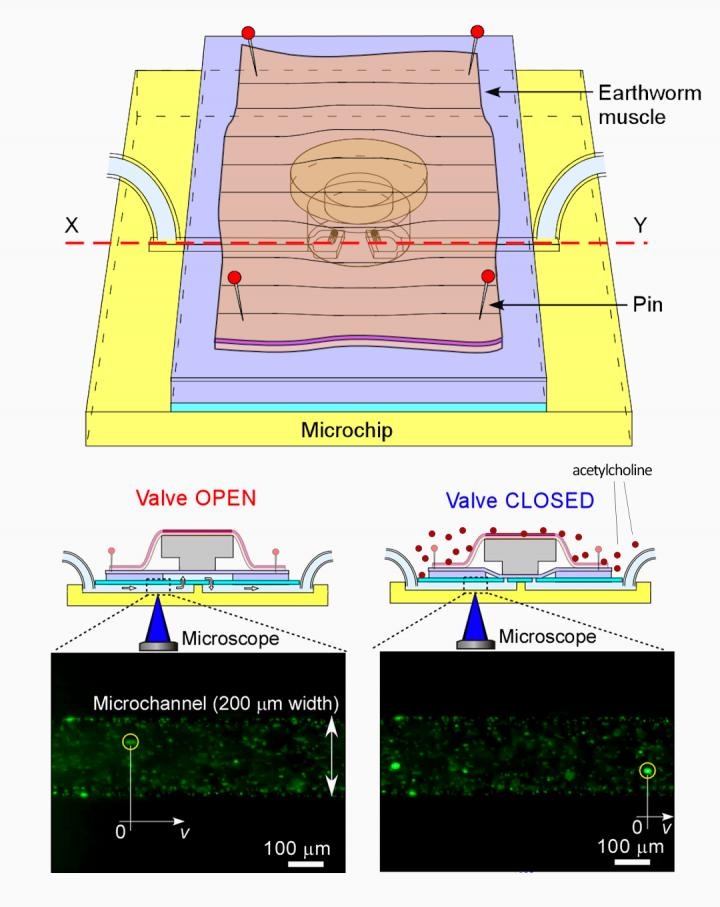Jul 10 2019
Researchers at the RIKEN Center for Biosystems Dynamics Research (BDR) in Japan have built the first microchip valve driven by living cells. Earthworm muscle tissue offers a high contractile force that could be sustained for minutes, and in contrast to electrically controlled valves, did not require any outer source of power such as batteries.
 A valve on a 2 cm × 2 cm chip powered by earthworm muscle. (top) Design of the valve seen from above. A sheet of earthworm muscle covers a pushbar that sits above a microchannel. (bottom) Cross-sectional views through the microchannel when the valve is open (left) and closed (right). Still images of fluorescently labeled microparticles were taken from the video clip at the top of the article. (Image credit: RIKEN)
A valve on a 2 cm × 2 cm chip powered by earthworm muscle. (top) Design of the valve seen from above. A sheet of earthworm muscle covers a pushbar that sits above a microchannel. (bottom) Cross-sectional views through the microchannel when the valve is open (left) and closed (right). Still images of fluorescently labeled microparticles were taken from the video clip at the top of the article. (Image credit: RIKEN)
For several years, scientists have been attempting to integrate microelectromechanical systems (MEMS) with living material. Bio-MEMS have numerous applications, ranging from better drug delivery and electrochemical and optical sensors to organs-on-chips.
Researchers from RIKEN BDR and Tokyo Denki University have been working on a bio-MEMS that is powered by real muscle, which could be beneficial in surgical implants. Based on their on-chip micropump design, the new research is the proof-of-concept for an on-chip muscle-powered valve.
In mechanics, an actuator is the component of a machine that regulates a mechanism by making it move, for example, the opening and closing of a valve. Actuators need a power source and a control signal, which are normally electric current or some type of fluid pressure.
The key benefit for using muscles as actuators in bio-MEM systems is that they can be driven in a similar manner as they are in living bodies: chemically. For muscles, the signal for contraction is the molecule acetylcholine—which is supplied by neurons—and the energy source is adenosine triphosphate (ATP)—which is present inside muscle cells.
Not only can our bio-MEMS work without an external power source, but unlike other chemically driven valves that are controlled by acids, our muscle-driven valve runs on molecules that are naturally abundant in living organisms. This makes it bio-friendly and especially suited for medical applications in which the use of electricity is difficult or not advised.
Yo Tanaka, Study First Author, RIKEN BDR
The team at first established that a small 1 cm × 3 cm sheet of earthworm muscle could create an average contractile force of around 1.5 milli-newtons over a two-minute period when triggered by a tiny amount of acetylcholine. Using this data, they construct a microfluid channel and valve on a 2 cm × 2 cm microchip that could be regulated by the contraction/relaxation of earthworm muscle.
For testing the system, they used a microscope to track fluorescently labeled microparticles in liquid as they moved through the microchannel. When acetylcholine was applied, the muscle contracted. The resulting force was transduced to a bar that was forced down to shut the valve, which effectively halted the flow of liquid. When the acetylcholine was cleaned away, the muscle relaxed, the valve re-opened, and the flow of fluid began again.
Now that we have shown that on-chip muscle-driven valves are possible, we can work on improvements that will make it practical. One option is to use cultured muscle cells. This might enable mass-production, better control, and flexibility in terms of shape. However, we will have to account for the reduction in the amount of force that can be produced this way compared with real muscle sheets.
Yo Tanaka, Study First Author, RIKEN BDR